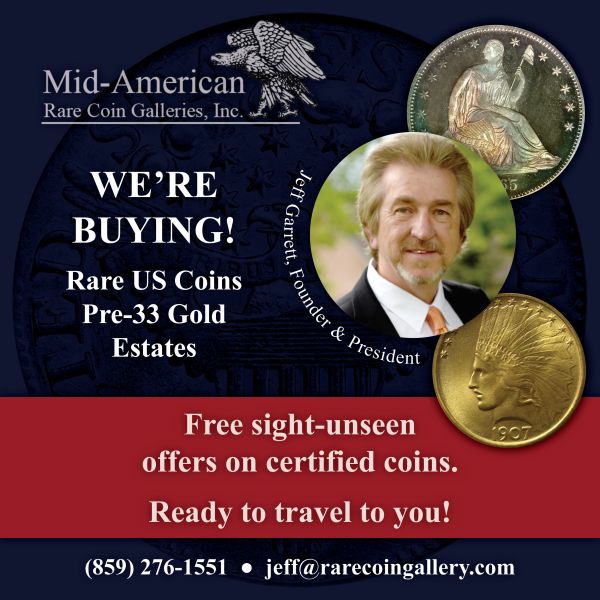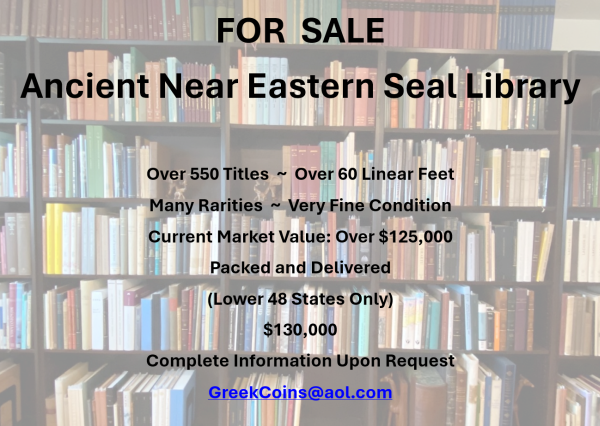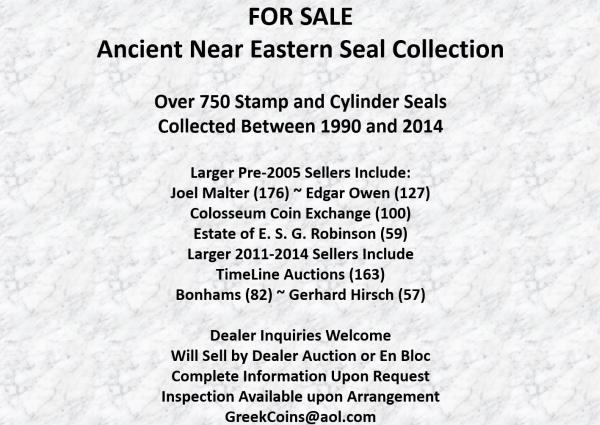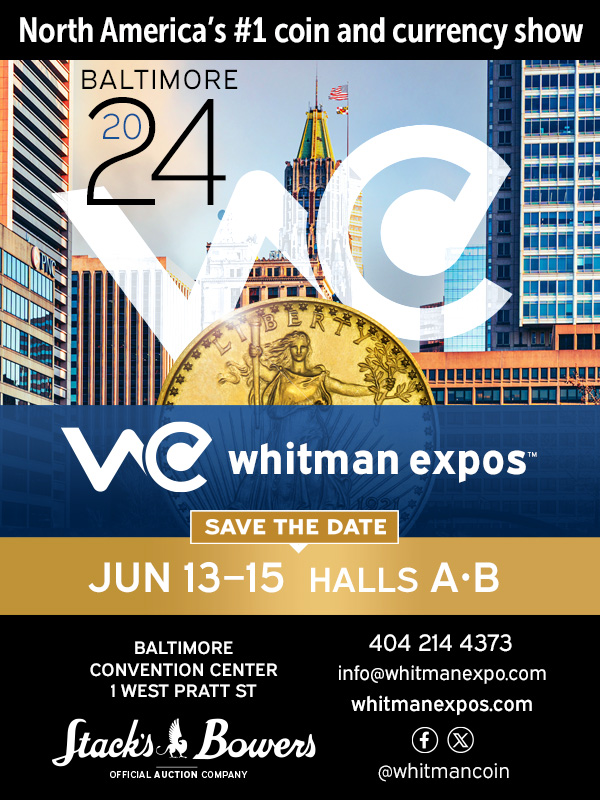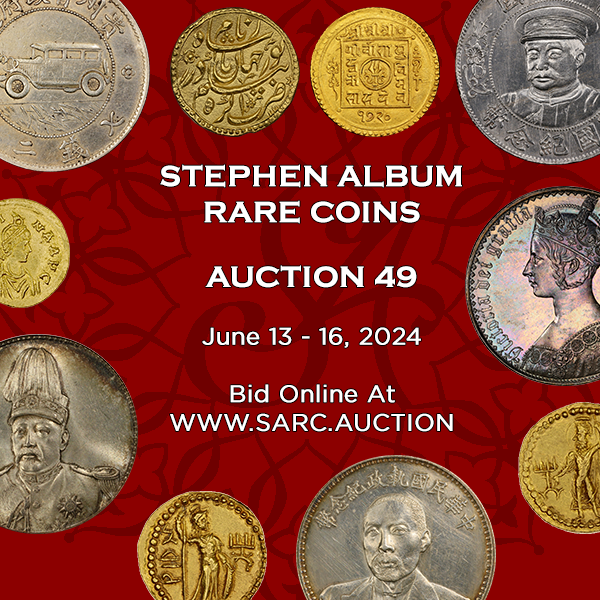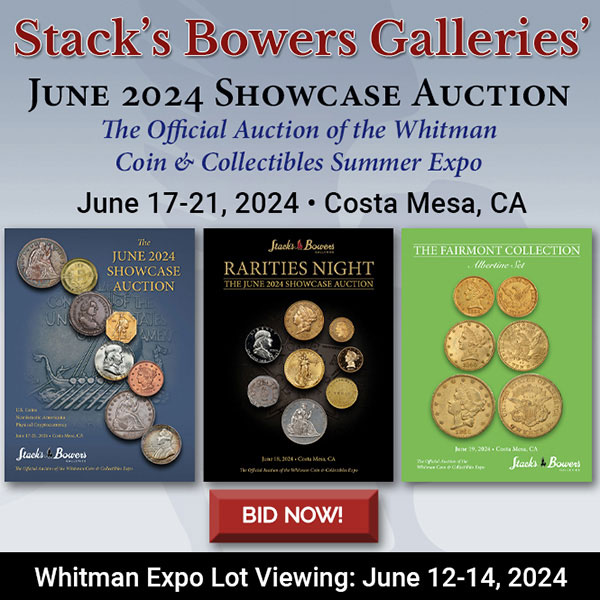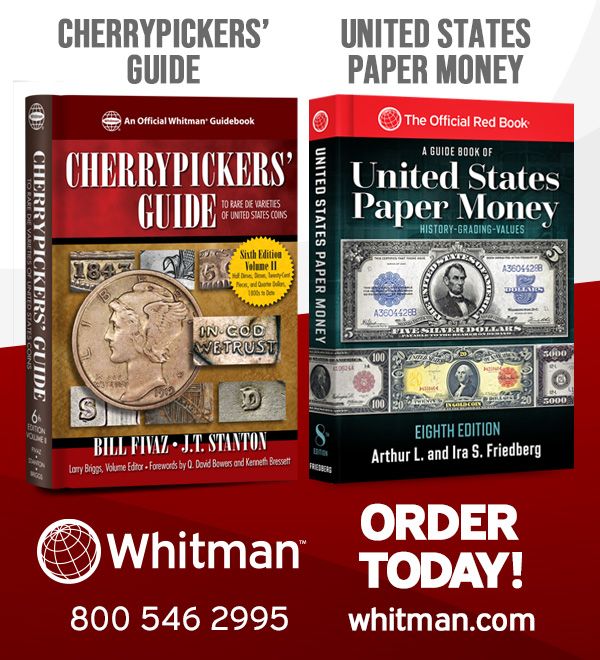
Visit our NBS Sponsors



About UsThe Numismatic Bibliomania Society is a non-profit association devoted to the study and enjoyment of numismatic literature. For more information please see our web site at coinbooks.org SubscriptionsThose wishing to become new E-Sylum subscribers (or wishing to Unsubscribe) can go to the following web page link MembershipThere is a membership application available on the web site Membership Application To join, print the application and return it with your check to the address printed on the application. Print/Digital membership is $40 to addresses in the U.S., and $60 elsewhere. A digital-only membership is available for $25. For those without web access, write to: Jeff Dickerson, Treasurer AsylumFor Asylum mailing address changes and other membership questions, contact Jeff at this email address: treasurer@coinbooks.org SubmissionsTo submit items for publication in The E-Sylum, write to the Editor at this address: whomren@gmail.com BUY THE BOOK BEFORE THE COIN |
- WAYNE'S WORDS: THE E-SYLUM JUNE 2, 2024
- KOLBE & FANNING JUNE 2024 SALE SELECTIONS
- SHANNA SCHMIDT ON K-F AUCTION 170
- NEW BOOK: CANADIAN DECIMAL COINAGE
- NEW BOOK: HENNING NICKELS
- CATALOGUING THE BMC GREEK CATALOGUES
- DETECTORIST DISCOVERS RARE COIN TESTER
- VIDEO: EARLY AMERICAN NUMISMATIC ICONOGRAPHY
- NOTES FROM E-SYLUM READERS: JUNE 2, 2024
- ACEF LAUNCHES TRUSTED EXPERTS DIRECTORY
- VOCABULARY TERM: PLASTER RESIDUE
- AN EARLY WOMAN NUMISMATIST
- 50 YEARS OF HARVARD STOLEN COIN SEARCH
- HOW THE BRITISH MUSEUM THEFT WAS EXPOSED
- NUMISMAGRAM MEDAL SELECTIONS: JUNE 2, 2024
- EARLY AMERICAN HISTORY JUNE 8, 2024 SALE
- KUENKER SALE 407-408 HIGHLIGHTS
- DAVISSONS E-AUCTION 49
- "RENOVATIO MONETAE" AND PROFIT FROM COINS
- CZECH WOMAN FINDS MEDIEVAL COIN HOARD
- POLISH FRAUDSTER'S HOARD DISCOVERED?
- THE 2024 D-DAY LANDINGS 50 PENCE
- NOBEL PRIZE MEDAL DONATED TO CAMBRIDGE
- JEWISH-AMERICAN HALL OF FAME MEDALS END
- BANKNOTE PRINTER DE LA RUE MAY BE SOLD
- REPORT: HIRST 'THE CURRENCY' WORKS BACKDATED
- COLOMBIA STAKES CLAIM ON SAN JOSE WRECK
- THE JOY OF FINDING LOST COINS
Content presented in The E-Sylum is not necessarily researched or independently fact-checked, and views expressed do not necessarily represent those of the Numismatic Bibliomania Society.
WAYNE'S WORDS: THE E-SYLUM JUNE 2, 2024
 New subscribers this week include:
Curt Radabaugh, courtesy Pat McBride.
Welcome aboard! We now have 7,260 subscribers.
New subscribers this week include:
Curt Radabaugh, courtesy Pat McBride.
Welcome aboard! We now have 7,260 subscribers.
Thank you for reading The E-Sylum. If you enjoy it, please send me the email addresses of friends you think may enjoy it as well and I'll send them a subscription. Contact me at whomren@gmail.com anytime regarding your subscription, or questions, comments or suggestions about our content.
This week we open with more selections from the upcoming Kolbe & Fanning numismatic literature sale, two new books, notes and updates from the Newman Numismatic Portal, and more.
Other topics this week include the Anti-Counterfeiting Educational Foundation, the Fogg Museum robbery, the British Museum theft, fixed price and auction previews, coin hoards, the D-Day commemorative 50p, a Nobel Prize medal on exhibit, the Jewish-American Hall of Fame medal series, banknote printer De La Rue, and the billion-dollar bounty of the San Jose shipwreck.
To learn more about the Richard B. Winsor collection, the Dunham–Clarke Encased Postage Stamp collection, Canadian Decimal coinage, Henning nickels, the Maranville Pocket Coin Tester, Michael Douglas as Ben Franklin, the London Elephant Token, renovatio monetae coinage, Damien Hirst’s project 'The Currency' and the numismatic boudoir of Miss Daisy Deutz, read on. Have a great week, everyone!
Wayne Homren
Editor, The E-Sylum
KOLBE & FANNING JUNE 2024 SALE SELECTIONS
Here are additional selections from the next Kolbe & Fanning numismatic literature sale, featuring books on ancient, world and U.S. numismatics. -Editor
 On Saturday, June 15, 2024, Kolbe & Fanning Numismatic Booksellers will be conducting our next auction of rare and out-of-print numismatic literature from around the world. The sale features over 500 lots of material on ancient, world and U.S. numismatics from the libraries of Wayne Homren and other consignors. Some highlights of the sale include:
On Saturday, June 15, 2024, Kolbe & Fanning Numismatic Booksellers will be conducting our next auction of rare and out-of-print numismatic literature from around the world. The sale features over 500 lots of material on ancient, world and U.S. numismatics from the libraries of Wayne Homren and other consignors. Some highlights of the sale include:
Some highlights of this first sale include:
SHANNA SCHMIDT ON K-F AUCTION 170
In her Newsletter #215, ancient coin dealer, bibliophile and NBS Board member Shanna Schmidt published these notes on the upcoming Kolbe & Fanning numismatic literature sale. -Editor
Kolbe & Fanning Auction 170 (15 June 2024)
K&F will hold their 170th auction with 508 lots. As many of you know, I pride myself on my ever expanding numismatic literature and catalog libraries. I even have a fancy name now to go along with those libraries, the S&S Library. All joking aside, numismatic books are an integral part of collecting. Those that endeavor to begin this wonderful journey can only go so far without the aid of a good library. I’m thankful for my friends David and Maria Fanning and their ability to bring us some pretty amazing sales. Anyone dealing in books has to be passionate. There is no way around it. The sheer weight of lugging books is enough to make you search for a great massage therapist.
This sale has another round of material from the Wayne Homren library. Wayne, is another bibliophile, who is the editor of The E-Sylum, He’s the one that sends you that long list of numismatic news every Sunday night. He features a lot of news on upcoming available books as well which is always helpful.
THE BOOK BAZARRE
NEW BOOK: CANADIAN DECIMAL COINAGE
The Royal Canadian Numismatic Association and the J. Douglas Ferguson Historical Research Foundation helped publish and distribute Rob Turner's new book on the Canadian Decimal Coinage from 1867 to 1907. Here's the announcement. -Editor
Dominion Decimals - Canadian Decimal Coinage from 1867 to 1907
Rob Turner (Author)
Royal Canadian Numismatic Association
 Do you know the introduction of that catalogue, or the opening paragraphs of that article about those coins or tokens? That text that gives the coins historical context, gives them a reason for their existence. That is what Rob Turner’s new book, Dominion Decimals, Canadian Decimal Coinage from 1867 to 1907, is for the decimal series of coins from the first 40 years of confederation.
Do you know the introduction of that catalogue, or the opening paragraphs of that article about those coins or tokens? That text that gives the coins historical context, gives them a reason for their existence. That is what Rob Turner’s new book, Dominion Decimals, Canadian Decimal Coinage from 1867 to 1907, is for the decimal series of coins from the first 40 years of confederation.
Rob Turner, the 2020 recipient of the J. Douglas Ferguson Award, the highest award in Canadian numismatics, has spent decades researching Canada's large cent series. He has visited many museums, libraries, and archives to assemble so much information that was unknown before. But this work is more than just a reference book on coins, it's designed to preserve and present information that is not accessible to most numismatists.
NEW BOOK: HENNING NICKELS
Joe Cronin has published the first modern study of the counterfeit Jefferson nickels produced by Francis LeRoy Henning. Here's his eBay description. Thanks to Utah Numismatic Society Mint Master Editor Doug Nyholm for his mention of the book in the latest issue. -Editor
The Henning Nickels Collectors' Guide
by Joe Cronin
 Yes, I am the same author who wrote Mint Errors to Die For, and I am also one of the foremost experts on Henning nickels and have made many new discoveries on them in recent years. My book is loaded with up-to-date, detailed information you won't find anywhere else on any web page, YouTube video, or social media page. It's loaded with HD photos, close-ups, recent sale prices, and other good online and literary resources you should use to make you a more informed collector.
Yes, I am the same author who wrote Mint Errors to Die For, and I am also one of the foremost experts on Henning nickels and have made many new discoveries on them in recent years. My book is loaded with up-to-date, detailed information you won't find anywhere else on any web page, YouTube video, or social media page. It's loaded with HD photos, close-ups, recent sale prices, and other good online and literary resources you should use to make you a more informed collector.
In the 1950s, Francis Leroy Henning counterfeited around 500,000 Jefferson nickels and roughly 100,000 made it into circulation. His fakes have become increasingly popular and valuable over time whereby selling prices range between $150 - $900+.
The purpose of this book is to tell you how to properly identify them as much of the information out there is either incomplete or just plain wrong. Learn about obverse and reverse die markers, what the dates are, what diagnostic tests should be performed to verify authenticity, if weighing them is really a good option, and discover some newly-discovered reverse dies and die markers that will make you re-check all your Jefferson nickel stashes. I also cover what Henning nickels *should not* look like, how to know what they're worth, and I even include some other valuable fake coins out there that collectors love to find.
CATALOGUING THE BMC GREEK CATALOGUES
Newman Numismatic Portal Project Coordinator Len Augsburger provided this summary of the British Museum’s Catalogue of Greek Coins. -Editor
Numbering the British Museum’s Catalogue of Greek Coins (1877-1927) Volumes
The study of numismatics quickly leads toward a pedantic path, and it is unlikely this article will do anything to lift the bar higher (or lower, depending on the reader’s viewpoint).
DETECTORIST DISCOVERS RARE COIN TESTER
Newman Numismatic Portal Project Coordinator Len Augsburger also provided the following report of a recent metal-detecting find researched through NNP. Very nice! -Editor
Metal Detectorist Discovers Rare Coin Tester
Terry Amburgey, metal detectorist, recently wrote to Newman Portal “I was metal detecting at a city park. I dug up a piece of brass and threw [it] in my pouch. Took it home and cleaned it up. I saw some writing and numbers. My wife did some research and came across this paper.” The paper Amburgey refers to is “1860 Maranville Improved Pocket Coin Tester,” contributed to Newman Portal by Malcolm Mathias in 2019. We reported Amburgey’s find to Mathias, who responded enthusiastically.
VIDEO: EARLY AMERICAN NUMISMATIC ICONOGRAPHY
The David Lisot Video Library on the Newman Numismatic Portal can be found at:
https://nnp.wustl.edu/library/multimediadetail/522852
We highlight one of his videos each week in The E-Sylum. Here's one from 2005 with Doug Mudd speaking about the political usage of imagery on Early American coinage. -Editor
NOTES FROM E-SYLUM READERS: JUNE 2, 2024
Howard Gibbs' Latin American Crowns
Brian Boosi writes:
 "I was excited to see the Howard Gibbs archives at the upcoming K&F sale. My collection is focused on Latin American crowns, and I think a few of my coins came from Gibbs. The first being an 1846 Ecuador 8 reales which was plated in Gibbs 1951 Schulman sale. The photo isn’t perfect but both Carlos Jara and I agree the match is likely.
"I was excited to see the Howard Gibbs archives at the upcoming K&F sale. My collection is focused on Latin American crowns, and I think a few of my coins came from Gibbs. The first being an 1846 Ecuador 8 reales which was plated in Gibbs 1951 Schulman sale. The photo isn’t perfect but both Carlos Jara and I agree the match is likely.
"The second is the Jamaican 8S6P which was played in the Byrne sale and likely the same unplated coin from Gibbs final sale of cut and countermarked coins.
"I'm looking forward to bidding and hopeful there is some information in the archives. Best of luck on the sale."
Thanks, and good luck yourself. Howard Gibbs and Ray Bryne were before my time in Pittsburgh numismatics, but I would have loved the opportunity to meet them and see their great collections. -Editor
To read the earlier E-Sylum article, see:
THE HOWARD GIBBS ARCHIVES
(https://www.coinbooks.org/v27/esylum_v27n21a18.html)
Other topics this week include James Risk's Orders and Decorations, the Canadian Antiquarian & Numismatic Journal, and Michael Douglas as Ben Franklin. -Editor
ACEF LAUNCHES TRUSTED EXPERTS DIRECTORY
In this press release, the Anti-Counterfeiting Educational Foundation (ACEF) announces a new directory of 'Trusted Experts'. -Editor
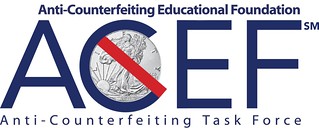 The Anti-Counterfeiting Educational Foundation has launched at its website
a Trusted Experts Directory to provide the public with an easy and practical way to locate professional
dealers and experts who buy and sell genuine coins and numismatic collectibles.
The Anti-Counterfeiting Educational Foundation has launched at its website
a Trusted Experts Directory to provide the public with an easy and practical way to locate professional
dealers and experts who buy and sell genuine coins and numismatic collectibles.
“Thousands of people looking for bargains are being scammed every day by vendors on popular e-commerce platforms selling counterfeit coins and numismatic collectibles. Most Americans don’t realize they are buying fakes until they go to sell. Then they learn the counterfeits they’ve bought online are worthless and even worse, illegal to possess, ” said John Albanese, president of the non-profit U.S.-based foundation devoted to creating awareness and assisting law enforcement in combatting counterfeits in the coin marketplace in the United States.
VOCABULARY TERM: PLASTER RESIDUE
Here's another entry from Dick Johnson's Encyclopedia of Coin and Medal Terminology. -Editor
Plaster Residue. A hard gray-white substance found in the crevices of a numismatic item, which had once been cleaned or used as a pattern for a plaster cast. Evidence of such residue indicates the piece was mistreated by a previous owner. Two possibilities exist: (1) it was cleaned with a pumice-based cleanser, or (2) it was used as the pattern to make a plaster of Paris casting. It is difficult to identify which residue – the dried pumice or hardened plaster – is present. If the remainder of the piece is harshly cleaned it may be assumed to be the first possibility and then called pumice residue.
AN EARLY WOMAN NUMISMATIST
E-Sylum Feature Writer and American Numismatic Biographies author Pete Smith submitted this article about an early female U.S. coin collector. Thanks! -Editor
Past issues of the E-Sylum have discussed women numismatists and perhaps who may have been among the earliest. While I was looking into the topic, I came across a story that was repeated in more than thirty newspapers in 1899.
50 YEARS OF HARVARD STOLEN COIN SEARCH
Here's an article from The Harvard Crimson about the notorious 1973 coin robbery at Harvard's Fogg Art Museum. Thanks to Len Augsburger for passing this along. -Editor
On a December night in 1973, five armed men broke into Harvard’s Fogg Art Museum and stole more than 6,000 ancient Greek and Roman coins — an incident that The Crimson reported at the time was “believed to be the largest art theft in U.S. history.”
Minted between the seventh century B.C.E. and the fourth century C.E., the silver, gold, and bronze coins were worth approximately $2 million — more than $8.5 million today. A University press release after the theft said they were a “fundamental” and “irreplaceable” part of Harvard’s teaching collection.
In the following months and years, the University and federal law enforcement mobilized to find and catalog the missing coins. With the work of more than 40 FBI agents assigned to the case, approximately 85 percent of the original collection has since been retrieved.

HOW THE BRITISH MUSEUM THEFT WAS EXPOSED
This BBC News article goes into depth on how the recent thefts from the British Museum were exposed. No artificial intelligence required - just the real intelligence of a human with a photographic memory and a library of catalogues. Here's an excerpt - see the complete article online. -Editor
In 2020, Danish antiquities dealer Dr Ittai Gradel began to suspect an eBay seller he had been buying from was a thief who was stealing from the British Museum.
More than two years later, the museum would announce that thousands of objects were missing, stolen or damaged from its collection. It had finally believed Dr Gradel - but why had it taken so long for it to do so?
NUMISMAGRAM MEDAL SELECTIONS: JUNE 2, 2024
Numismagram's Jeremy Bostwick sent along these four medals from his most recent upload of new material to his site. For all of the new items, please visit https://www.numismagram.com/inventory. -Editor
102560 | GERMANY. Hamburg. Satirical silver Medal. Issued circa 1708 or slightly thereafter. The supposed corruption of the imperial commission by the Jewish community (29mm, 5.46 g, 3h). By the Loos workshop in Berlin. KOMSTU MIR ALSO (if you'll scratch my back...), hand putting forth numerous coins // SO KOMME ICH DIR SO (...I'll scratch yours), bust facing slightly right, with hand nearly covering face, though with eyes peering through; LOOS on sleeve. Edge: Plain. GPH 1220; Fieweger Coll. 343. PCGS MS-63. Deep gray toning, with some scattered iridescence and flashy brilliance when catching the light. One of the finest examples of the type that one can hope to encounter. We sold a somewhat more colorful though smaller and lesser graded example for $985 last fall. $985.
To read the complete item description, see:
102560 | GERMANY. Hamburg. Satirical silver Medal
(https://www.numismagram.com/product-page/102560)
EARLY AMERICAN HISTORY JUNE 8, 2024 SALE
Here are several selections from the upcoming Early American History Auctions sale. Some very nice colonial-era material. -Editor
Early American History Auctions, Inc. Announces A New Online Only Auction of 287 Lots Closing: Saturday June 8th, 2024
Featuring A Wide Array of Historic Americana is Offered “Online Only” Including: Autographs, Documents, Colonial Coinage & Currency, Medals; U.S. Navy, George Washington, Historical Liverpool Creamware; Political & Decorative Americana & Abraham Lincoln and More!
KUENKER SALE 407-408 HIGHLIGHTS
Here's the press release for the June 2024 Künker sales. Nice coins, some seldom seen. -Editor
Special Collections at Künker in June: Scandinavia, Mainz and 19th-Century Germany
From 18 to 21 June 2024, Osnabrück will shine in the light of numismatics. Once again, collectors from all over the world have entrusted Künker’s specialists with the sale of the coins that they assembled over many years. This is why several special collections will be auctioned off at once. Particularly extensive are:
- a collection of Scandinavian coins
- a collection of 19th-century German coins
- a collection of Mainz gold coins
In addition, there is a comprehensive ensemble of yield and mining issues from the Preussag AG Collection, a small special collection with Wismar issues as well as a wide range of patterns from the Coenen Collection.
Künker’s auction sales are always a social event. So take the time to participate in the sale on site and enjoy a nice chat with like-minded people during the breaks! Künker’s customer service would be delighted to help you find an accommodation in Osnabrück.
DAVISSONS E-AUCTION 49
Davissons is holding their E-Auction 49 on June 26th. Here's Allan Davisson's introductory note to the catalog. -Editor
 E-Auction 49, closing Wednesday, June 26th 2024, is online now! Print copies were mailed recently, if you are not on our mailing list and would like a copy please let us know.
E-Auction 49, closing Wednesday, June 26th 2024, is online now! Print copies were mailed recently, if you are not on our mailing list and would like a copy please let us know.
E-Auction 49 opens with gold coins—some where the values are numismatically based and a larger group whose numismatic cost premium has been practically eclipsed by the recent jumps in the value of gold.
The best numismatic piece in this sale is a choice “sword and scepter” Scottish piece of James VI (Lot 7 from the Leland Scott collection), a particularly choice example of an issue that often shows up with problems. This example is well struck, well centered on a lustrous flan free of clips, blunders, bends or any of the problems that frequently appear on this issue.
"RENOVATIO MONETAE" AND PROFIT FROM COINS
Economist JP Koning recently published an article on the medieval practice of short-lived renovatio monetae coinage. Here's an excerpt - see the complete article online. -Editor
A king or queen generally resorted to two different strategies for profiting from the mints. The first was to mint long-lived coinage. The second involved issuing short-lived coinage subject to a policy of renovatio monetae, which is the topic of this post.
Almost everything I've written about medieval coinage on this blog has been about the long-lived sort, because that was the dominant pattern in Europe. Under a long-lived coinage system, once a coin had been minted it remained in permanent legal circulation. For example, England's long-lived coinage policy meant that an English penny produced in 1600 would have been just as valid a hundred years later, in 1700, as a penny produced in 1699.
CZECH WOMAN FINDS MEDIEVAL COIN HOARD
A Czech woman happened across a hoard of medieval silver denarii. Thanks to Howard Berlin and Leon Saryan (Fox News articles) and Paul Horner (AOL and WordPress articles). -Editor
While out on a stroll in the Kutnohorsk Region of the Czech Republic, a woman happened upon a roughly 900-year-old stash of more than 2,150 medieval silver coins known as denarii.
The silver coins were likely buried between 1100 and 1125 during a time of regional instability, explained Velímský in the release. The coins were originally stored in a pottery container but were scattered by later agricultural activities.
Dubbed one of the greatest finds of the last decade, institute archaeologist Filip Velímský believes the discovery is like winning a prize in the lottery—even if someone else was the loser. “It was probably placed in its place during the first quarter of the 12th century, at a time of internal political instability,” he said. “At that time, there were disputes in the country between the members of the Premysl dynasty about the princely throne of Prague.”
The depot could have been cash "for paying wages or spoils of war."
POLISH FRAUDSTER'S HOARD DISCOVERED?
Bob Evans submitted this article about the find of an 18th-century coin hoard in Poland. Thanks. -Editor
A Polish group searching for lost treasure has discovered a collection of coins that may have belonged to a notorious early 18th-century con artist.
Legend has it that the fraudster, Antoni Jaczewicz, built a hermitage in the mountains, where he would trick people into thinking he had religious healing powers for money.
The Swietokrzyska Exploration Group originally found the coins using metal detectors in south-central Poland's Jeleniowskie mountain range in 2022, according to a Facebook post from the Provincial Office for the Protection of Monuments in Kielce.
According to a statement, the group waited almost two years to announce the findings, and can now confirm the true story of the legend.
THE 2024 D-DAY LANDINGS 50 PENCE
David Pickup passed along this BBC article on the new D-Day commemorative 50p. Thanks! -Editor
A new coin is set to be released to mark 80 years since the D-Day landings during World War Two.
The 50p coin was unveiled by the Royal Mint, in Llantrisant, Rhondda Cynon Taf, ahead of the 6 June anniversary.
On that day, in 1944, Allied forces landed across five beaches in northern France, with the attacks given the codenames Utah, Omaha, Gold, Juno and Sword.
NOBEL PRIZE MEDAL DONATED TO CAMBRIDGE
Like many numismatists, I'm of two minds when it comes to museum donations. While it's nice in theory to have collections accessible to the general public, in practice it's difficult to attract and pay for the curatorial and security staff required to do a numismatic collection justice. Only the largest museums have those resources, and unless numismatics is their main focus, numismatic material can get neglected. But in the case of this Nobel Prize Medal donation to Cambridge, it feels like a perfect match. -Editor
Prof David Thouless, who studied at Trinity Hall, won the Nobel Prize in Physics in 2016, but died in 2019.
His family said they wanted it to be on display at the college because of "the influence that Trinity Hall had on his life".
The college's senior tutor, Michael Sutherland, said: "We hope that this generous gift inspires future generations of Trinity Hall physicists."
Prof Thouless won the Nobel Prize "for theoretical discoveries of topological phase transitions and topological phases of matter".
JEWISH-AMERICAN HALL OF FAME MEDALS END
They say "All good things must come to an end," and sometimes they're right. Mel Wacks has announced the end of the long-running series of high-quality medals issued by the Jewish-American Hall of Fame. Sorry to hear this news. -Editor
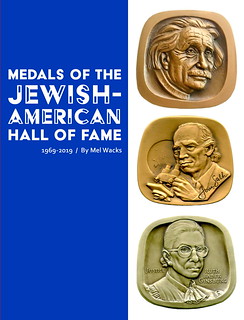 Mel Wacks, Director of the Jewish-American Hall of Fame, which was the longest series of medals being issued in the United States, has announced the end of the series due to the inability to find a mint to produce high quality medals at a reasonable cost. Wacks said “Every one of these medals has a story to tell. Every medal that we have issued from 1969 through 2023 is a numismatic ambassador fighting antisemitism - whether it is the story of how Haym Salomon died penniless after giving over $300,000 to support the American Revolution, or how Jonas Salk insisted that the Polio vaccine belongs to the world rather than bringing him personal profit. Or how Gertrude Elion battled misogyny to develop drug treatments that have saved millions of lives around the world, or how Irving Berlin wrote God Bless America and donated the profits to the Boy and Girl Scouts.”
Mel Wacks, Director of the Jewish-American Hall of Fame, which was the longest series of medals being issued in the United States, has announced the end of the series due to the inability to find a mint to produce high quality medals at a reasonable cost. Wacks said “Every one of these medals has a story to tell. Every medal that we have issued from 1969 through 2023 is a numismatic ambassador fighting antisemitism - whether it is the story of how Haym Salomon died penniless after giving over $300,000 to support the American Revolution, or how Jonas Salk insisted that the Polio vaccine belongs to the world rather than bringing him personal profit. Or how Gertrude Elion battled misogyny to develop drug treatments that have saved millions of lives around the world, or how Irving Berlin wrote God Bless America and donated the profits to the Boy and Girl Scouts.”
The 54 Jewish-American Hall of Fame medals were created by a Who’s Who of America’s greatest medalists - winners of the American Numismatic Society’s J. Sanford Saltus Award for Signal Achievement in the Art of the Medal (Eugene Daub, Alex Shagin, and Karen Worth) and the American Numismatic Association’s Numismatic Art Award for Excellence in Medallic Sculpture (Eugene Daub, Virginia Janssen, Jim Licaretz, Hal Reed, Alex Shagin, Marika Somogyi, Paul Vincze, Gerta Ries Wiener, and Karen Worth).
BANKNOTE PRINTER DE LA RUE MAY BE SOLD
Banknote printer De La Rue is in the news after announcing a potential sale. -Editor
The company behind Britain’s banknotes is considering breaking up its business just a day after Royal Mail fell into the hands of a foreign buyer.
De La Rue, which prints notes for the Bank of England and half of the world’s central banks, is delaying its full-year results to July as it talks with ‘a number of parties’.
It recently collaborated with the Bank of England on new banknotes featuring the King’s portrait, which will enter circulation next Wednesday.
REPORT: HIRST 'THE CURRENCY' WORKS BACKDATED
English artist Damien Hirst’s project 'The Currency' is drawing criticism following a report that a number of the works were backdated. -Editor
At least 1,000 paintings that the artist Damien Hirst said were “made in 2016” were created several years later, the Guardian can reveal.
Hirst produced 10,000 of the paintings, each comprising colourful hand-painted dots on A4 paper, as part of a project called The Currency that was born from the idea of creating a form of money from art.
The year 2016 was inscribed on the works beside the artist’s signature. Hirst and the authorised seller of the paintings repeatedly said the physical works were created in 2016.
COLOMBIA STAKES CLAIM ON SAN JOSE WRECK
Colombia has made the latest move in the complicated legal chess game of deep sea salvage. Here's an excerpt from a CBS News article - see the complete article online. -Editor
Colombia on Wednesday declared a "protected archeological area" around the spot where the legendary San Jose galleon sank off its Caribbean coast more than three centuries ago laden with gold, silver and emeralds believed to be worth billions of dollars.
The designation, said the culture ministry, "guarantees the protection of heritage" through the ship's "long-term preservation and the development of research, conservation and valuation activities."
THE JOY OF FINDING LOST COINS
Nothing numismatic here, but the Wall Street Journal published an article about people who enjoy collecting coins found on the street. -Editor
There are two types of people: those who overlook the glinting coins in their path, and those who never fail to spot them. Sarah Bowen Shea is firmly in the latter category.
The co-founder of the online community Another Mother Runner, she routinely scoops up coins during her runs. She discovered a Chicago Sacagawea coin worth $1.27 one January, and nabbed $1.22 worth of coins (including a quarter plucked from a pond) last July. Another time, she netted a whopping $4.33 in a single run.
“There’s definitely days where the search for found change is what gets me out the door,” says Shea, 58, of Portland, Ore.




